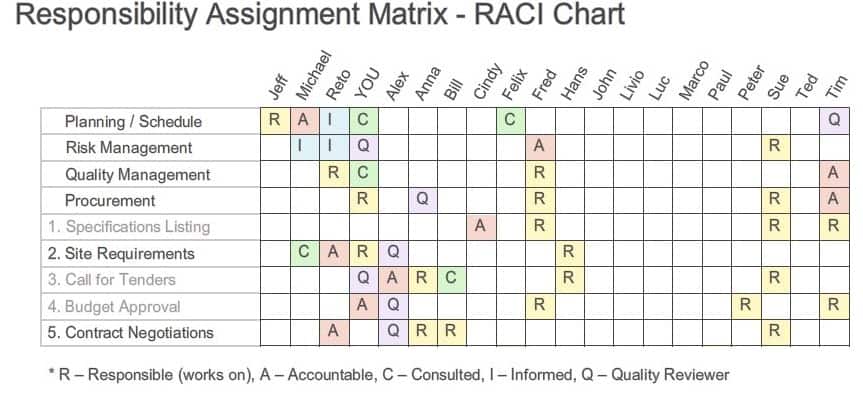Understanding the Responsibility Assignment Matrix (RACI Matrix)
The Responsibility Assignment Matrix also referred to as RACI Matrix or Responsibility Accountability Matrix is a key tool an organization can use to ensure successful completion of projects. The matrix helps managers know who plays what role or performs which duties during a project.
If this isn’t clearly defined it can lead to a common problem when carrying out projects, where conflicts arise over who is to do what, some team members having more workload, understaffing of the project and so on. That is why the RACI matrix comes in handy in project management. By developing the matrix a manager can ensure everybody knows what is expected of them and team members stick to specific roles assigned to them, therefore avoiding confusion and problems in the project.
The Four Roles in RACI Matrix
RACI is an acronym for Responsible, Accountable, Consulted and Informed the four roles team members can be assigned in a project. In the matrix, tasks are listed in the first column and project members in the top row of the table.
The Acronym RACI Stands For:
Responsible (R)
This refers to the individual who will perform a task. Each task has to have at least one person who completes it. If an R is missing in any of the matrix rows that task has not been assigned to anyone creating a gap that needs to be filled immediately. For tasks, they can be several people expected to perform it who then report to the person accountable.
Accountable (A)
This is the individual who is ultimately answerable for the decisions to be made for a task. They most likely are the project manager or a senior official who have final say over the tasks. To be efficient the number of people accountable for each task should not be many. For most projects one listed accountable person is ideal.
Consulted (C)
This is the go-to person for advice on the project. They should be an expert on matters relating to the project whose opinion is sort before making final decisions or taking certain action. For example, if you are working on technical tasks consultations with the IT administrator for expert advice will be necessary. The number of consultants per task, however, should be minimum. Too many C’s may prolong a task because of a lot of unnecessary deliberations and they might be a risk of poor plan execution.
Informed (I)
These are people in the team who have to be updated on the project progress or decisions. These individuals are in most cases informed once a task is completed and then take the necessary next step i.e. to mark that project as done, once update. Communication with the informed is usually one-way and they don’t contribute directly to the task.
Creating a RACI Matrix (Step-By-Step)
- Identify all project tasks and activities and put this on the left-hand side of the matrix according to how they will be completed.
- Identify all the individuals and groups involved in the project and list them at the top of the chart.
- Figure out who does what-This is a very crucial part of the formation of the matrix. Here the project manager identifies the people to be assigned to each task. While doing this ensure you match skill sets to tasks.
- Develop the matrix- At this stage, you assign team members their association. They will either be Responsible, Accountable, Consulted or Informed for each task. Best practice dictates that you start with the “R’s”- because they are the people performing the tasks necessary to complete the project. Then move on to the “A’s” who are ultimately answerable for the process. Finally, assign the “C’s” and ‘I’s” individuals who have no direct responsibility in the project but are needed for it to succeed.
- Share and discuss the RACI Matrix- when done constructing the matrix send it out to the team members involved and ask for feedback. From their feedback make any necessary changes. By doing this you will be ensuring you haven’t left anything important out and all involved are clear about what is required of them. The final matrix should be one that all stakeholders agree on before starting work on the process.
RACI Example
A company is working on developing an App that will boost its online sales. David is developing this App that will run on software developed by Mark. Simon is overseeing the project as manager and Irene is in marketing. David has the task of coming up with the App so in the matrix, he is the Responsible person. Simon is Accountable and Mark needs to be consulted because his software will run the App. Finally, Irene needs to be informed when the App is ready so that she can take the next step and promote it.
Questions to Ask Before Finalizing Your RACI Matrix
To be certain assignments are reasonable to ask these questions
- Are too many responsibilities given to one person? If so should they be given to someone else?
- Does every task have an appropriate number of consulted and informed?
- Does every role have a responsible and accountable person?
- In the case of complex tasks can smooth decision making be done by one accountable person or should there be more than one to ease decision making?
Once you answer these questions positively you can begin working with your matrix. That, however, doesn’t mean that the matrix should remain the same to the conclusion of the project. You have to constantly re-evaluate it and make changes when the need arises due to work changes over time.
Variations of RACI Matrix
They are other Responsibility Assignment models that add on to this matrix. Examples include :
RASIC– This has the RACI Matrix associations Responsible, Accountable, Consulted and Informed but adds a 5th association which is Supportive. These are individuals tasked with assisting the responsible party to perform the task.
RACIO– Also has a Responsible, Accountable, Consulted, Informed person but also includes Omitted. This is employees not involved in a task. This helps give clarity and ownership of roles.
RACI-VS– Here two more associations are also included. The two are “Verify” and “Sign off”. Verify, this means reviewing a task at the end to ensure it has been done and completed properly. Sign Off mostly happens at the very end and gives a seal of approval that a task has concluded successfully. These two steps should not be done for all project tasks, it should only be for tasks that absolutely require it.
Conclusion
As a project manager having a RACI Matrix will make you confident that roles and responsibilities are clearly defined for the team. Every task has a person doing it and duplication of work is unlikely to happen.
One of the best things the RACI Matrix helps get rid of is the passing of blame amongst team members because if work is not done it is very clear where the buck stops and who is letting the others down. The RACI Matrix is a good project management tool but it should be noted that it cannot address issues such as poor teamwork or low morale among employees for that you would have to figure out how to motivate the group, maybe by giving rewards for a successful project.







